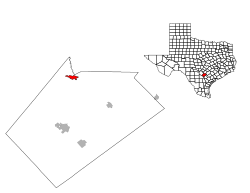La Vernia, Texas
| La Vernia, Texas | |
|---|---|
| City | |
 |
|
| Nickname(s): L V, Bear Country | |
| Motto: This is Bear Country | |
 Location of La Vernia, Texas |
|
 |
|
| Coordinates: 29°21′11″N 98°7′33″W / 29.35306°N 98.12583°WCoordinates: 29°21′11″N 98°7′33″W / 29.35306°N 98.12583°W | |
| Country | United States |
| State | Texas |
| County | Wilson |
| Area | |
| • Total | 2.4 sq mi (6 km2) |
| • Land | 2.4 sq mi (6 km2) |
| • Water | 0.0 sq mi (0 km2) |
| Elevation | 489 ft (149 m) |
| Population (2010) | |
| • Total | 1,034 |
| • Density | 430/sq mi (170/km2) |
| Time zone | Central (CST) (UTC-6) |
| • Summer (DST) | CDT (UTC-5) |
| ZIP code | 78121 |
| Area code(s) | 830 |
| FIPS code | 48-41764 |
| GNIS feature ID | 1360813 |
| Website | lavernia-tx.gov |
La Vernia is a city in Wilson County, Texas, United States. It is located is on the south bank of Cibolo Creek at the junction of U.S. Highway 87 and Texas Farm to Market Road 775, fifteen miles north of Floresville in northern Wilson County. The population was 1,034 in the 2010 census. It is part of the San Antonio Metropolitan Statistical Area.
The area known as present-day La Vernia was first inhabited by indigenous Native Americans of the Coahuiltecan speaking peoples of Texas and subsequently by nomadic bands of Apache and Comanche who migrated to Texas in the 17th century. One of the earliest land grants made was to Erastus "Deaf" Smith, also known as Deaf Smith. Deaf Smith married Guadalupe Ruiz Durán, a Mexican citizen who was descended from one of the original Tejano or Spanish Texas families; and as such, received a land grant from the Mexican government on the Cibolo River, north of present-day La Vernia in 1825. This area remained primarily unsettled by Europeans until 1837, when veterans from the recent wars of Independence from Mexico began to arrive.
La Vernia was first settled in earnest around 1850. W. R. Wiseman of Mississippi, who organized a Presbyterian church at the site around 1851, is said to have named the place Live Oak Grove, for a grove of trees nearby.
In 1853 a post office was established under the name Post Oak, which was changed to La Vernia in 1859. H. Suhre, owner of the general store, was the first postmaster. The origin of the name is uncertain. Although, in 1853 William Claiborne Rector was the postmaster at the local post office and during this time the town was still called Post Oak.
The town's current name came from the local Spanish vernacular for "green oaks", or "La Vernia“. Hence, the Brahan Masonic lodge was first established at "La Vernia" in 1859. The building also served as a school and church.
German and Polish immigration brought the population to 110 by 1885. The community was now served by three churches, a steam gristmill, and a cotton gin. H. Suhre was the owner of the general store. During this time the major crop grown was corn, being it was so universally useful. Cotton also proved to be an important commodity. In present-day La Vernia, corn and cotton are still major crops.
...
Wikipedia
